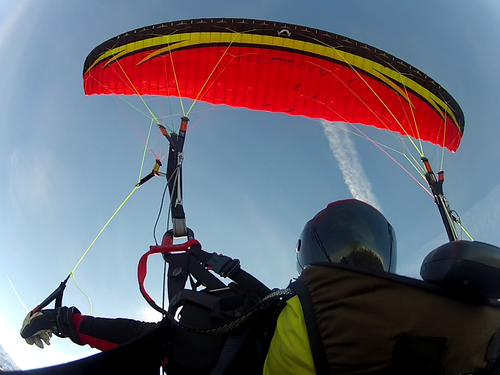Pioneer M |
|||||||||||||||||||||||||||||||||||||||||||||||||||||||||||||||||||||||||||||||||||||||||||||||||||||||||||||||||||


|
|||||||||||||||||||||||||||||||||||||||||||||||||||||||||||||||||||||||||||||||||||||||||||||||||||||||||||||||||||
Instability rating |
|||||||||||||||||||||||||||||||||||||||||||||||||||||||||||||||||||||||||||||||||||||||||||||||||||||||||||||||||||
|
|||||||||||||||||||||||||||||||||||||||||||||||||||||||||||||||||||||||||||||||||||||||||||||||||||||||||||||||||||
Glider characteristics |
|||||||||||||||||||||||||||||||||||||||||||||||||||||||||||||||||||||||||||||||||||||||||||||||||||||||||||||||||||
|
Launch preparations: easy
launch characteristics: balanced, climbs constantly, no guidance necessary, good feedback during inflation, moderate braking required, control check simple, low takeoff speed
asymmetric collapse: moderate dynamics, total course change 90-180°, (1), moderate course change rate, moderate forward pitching 45-60°, (2), moderate height loss 30-39 m, (2), moderate sink velocity 15-19 m/s, (2), G-Force < 2,5 G, (1)
Frontal collapse: moderate pitch backwards 30-45°, moderate pitch forwards 30-45°, moderate dynamics, course change 90-180°, (3), delayed recovery, asymmetric recovery, delayed return to normal airspeed, delayed reinflation of wingtips, high height loss 40-49 m, (3), low sink velocity 10-14 m/s, (1)
Spiral dives: rapid sink velocity increase, Very low G-Force < 3 G, (1), Sink velocity after 720° <18 m/s, (3), Moderate maximum sink velocity < 18 m/s, (2), no increase of sink velocity on brake release (1), Course change 360-540° after spiral exit, (3), moderate height loss during recovery 30-60 m, (2)
B-Stall: normal force required, moderate pitch backwards 15-30°, marked pitch forwards 30-45°, stable sink phase, low deformation tendency, immediate return to normal airspeed, 6-8 m/s, height loss on recovery < 20 m
big ears: simple initiation, stable flight phase, delayed automatic recovery, Vsink unaccelerated 2,5-3 m/s, Vsink accelerated 3,5-4 m/s, Vunaccelerated 3-5 km/h less than trimspeed, Vaccelerated 3-5 km/h faster than trimspeed |
|||||||||||||||||||||||||||||||||||||||||||||||||||||||||||||||||||||||||||||||||||||||||||||||||||||||||||||||||||
Notes |
|||||||||||||||||||||||||||||||||||||||||||||||||||||||||||||||||||||||||||||||||||||||||||||||||||||||||||||||||||
|
Launch Characteristic: Independences Pioneer is a little more dynamic, this canopy climbs faster and requires more brake appliance to stabilise. Asymmetric Collapse: Typical for the LTF-A class are the results from Independence (Pioneer M) and Icaro (Cyber TE M). Mojo 4 and Koyot 2 change course to a greater degree and suffer more height loss than the other test gliders. Front Collapse: Independence Pioneer opens with a slight to moderate delay, sometimes asymmetrically which then results in a course change and a greater height loss. Spiral Dive: Dynamic transition from entry to spiral. Glider collapses on outer ear at 15 m/s which resists further acceleration. Relatively low G-forces. B-Stall: Independences Pioneer displayed a slight tendency to deform on longer B-stalls. Big Ears: Performing big ears on all of the tested gliders was unproblematic. |
|||||||||||||||||||||||||||||||||||||||||||||||||||||||||||||||||||||||||||||||||||||||||||||||||||||||||||||||||||
Rating |
|||||||||||||||||||||||||||||||||||||||||||||||||||||||||||||||||||||||||||||||||||||||||||||||||||||||||||||||||||
|
Safety class 3 This class of paraglider react moderately to one or more of the following manoeuvres: frontal collapse, asymmetric collapse or spiral dive.Moderately means that the above manoeuvres result in dynamic reactions from the glider and/or large height losses. Good piloting skills which need to be regularly practised, together with good personal reaction times which are above basic training levels are required to safely fly this class of gliders. Skill and experience levels greater than those attained in basic training are required to safely recover from the above manoeuvres. Emergency descent manoeuvres, in particular spiral dives may require advanced recovery skills. Additional training such as regular ground handling or SIV training is recommended. |
|||||||||||||||||||||||||||||||||||||||||||||||||||||||||||||||||||||||||||||||||||||||||||||||||||||||||||||||||||

